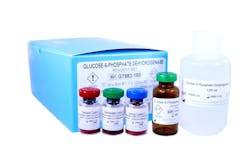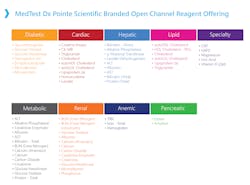Best practices in onboarding open channel reagents and suppliers
Although manufacturers of branded clinical chemistry analyzers provide robust test menus, they cannot meet every clinical laboratorian’s needs and budget. Open channel reagent suppliers fill the gaps in test menus, providing labs with an alternative means of securing controls and reagents that aren’t available from their instrument provider.
This enables laboratories to bring new diagnostic tests in-house to improve patient care—by reducing the time to test results, thus yielding faster diagnoses and treatment plan decisions. It can also generate additional revenue streams.
As such, open channel providers offer labs an important service. It’s imperative to carefully evaluate these suppliers for the quality of their assays, as well as the services and support they provide to ensure successful use on another manufacturer’s equipment.
This article explores the reasons for choosing an open channel assay, obstacles, and considerations when making a switch, and what to look for in a supplier of alternative reagents.
Why switch?
The most obvious circumstance for introducing an open channel reagent is because the instrument manufacturer doesn’t offer an assay that’s needed. This can be true for many specialty assays, but general chemistry assays as well.
Another reason to switch is performance. Sometimes the manufacturer’s branded assay simply doesn’t deliver the expected performance, and trying another reagent yields better results.
Finally, cost can lead labs to explore alternative reagents. It may be more economical to source an open channel assay after a lab has reached its purchase volume agreement with its instrument provider. There are some high-revenue assays that can be relatively expensive and using open channel capabilities may help cut costs after contractual obligations with the instrument vendor are met. Also, generics, as in pharmaceuticals, are typically more economically advantageous for the customer, and are available as open channel.
Obstacles to open channel
The makers of chemistry analyzers, reasonably, make their money from the sales of consumables used on the instrument. For that reason, they contract by test volume to ensure a steady, consistent use of their reagents with their instruments. They can also lock open channel reagents out of the instrument, forcing users to request—and sometimes pay for—permission to use alternative assays, or to purchase packaging components such as user-defined wedges that are compatible with their specific analyzer. This allows the open channel reagent to be poured into a component that is suitable for the analyzer.
While instrument manufacturers have safeguards in place that alert them to attempts to use open channel reagents, many have worked collaboratively with open channel reagent providers as a way to ensure customer satisfaction. Often, manufacturers without a specific assay will work with a third-party provider to get their customer the assays they need.
Considerations
As organizations consider open channel reagents, there are many things to evaluate. Among the first considerations is whether the chemistry analyzer has locked parameters or requires a special packaging component to add a third-party assay. If the instrument is provided with fully open channel capabilities, some manufacturers do not require labs to contact them for open channel use. For others, you may have to pay for this privilege or purchase the component.
You should also inquire if the open channel reagent requires an independent calibrator or control that must be purchased, or can you continue to use your current control for the assay being brought in?
For these additional expenses, what is the return on investment (ROI) of bringing the assay in-house? Does the testing volume warrant doing so? Is it being ordered consistently and frequently enough? For example, in a hospital offering chemotherapy treatment, the glucose-6 phosphate dehydrogenase (G6PD) prescreening testing method aids in determining the risk of possible adverse side effects (such as a hemolytic crises) of chemotherapy drugs on patients with a deficiency in G6PD. If there are enough chemotherapy patients, bringing the G6PD assay in-house may be beneficial for better, faster patient care decisions and for the hospital’s bottom line. Assessing the testing volume can help them decide if it’s in the hospital’s best interests to run the assay in-house.
Selecting an open channel supplier
Once clinical lab directors have decided that an open channel assay makes sense, finding the right supplier of that assay is key to overall success. There are several attributes to look for when selecting a supplier.
First and foremost, the supplier must offer the assay that’s needed. Among those with that assay, look for suppliers with a history in the industry of offering user-defined reagents, as well as one with a growing portfolio of assays to ensure you have increased choice as the relationship grows.
A record of quality and lot consistency is critical, as is a supplier who provides data analytics services. Compliance with current good manufacturing practices (cGMP) and International Organization for Standardization (ISO) certifications are also essential, as are reagents that carry the CE mark for sale into 31 European countries.
Regardless of your lab’s size, it can be important to work with a supplier that is capable of supporting small- to medium-sized hospitals and laboratories all the way up to and including ultra-high-volume commercial labs and core hospital test environments. Such scale ensures the supplier has support and processes in place for installation and validation, whether open on-board channeling and/or full line reagent conversions.
Finally, look for flexibility in their supplier program. Some suppliers will provide free samples or reagents for validation, while others will want upfront payment but offer discounts on subsequent purchases. In general, you want a supplier who will make a commitment to meet your needs, as you make a commitment to them.
Conclusion
Open channel reagents offer clinical laboratories an alternative choice for meeting complete diagnostic testing needs. Customers appreciate the ability to incorporate open channel reagents into their testing streams; it’s an absolute necessity when the maker of their chemistry analyzer doesn’t offer the assay, and it’s a difference-maker when performance and cost affect the lab’s overall productivity and commitment to patients.
About the Author

Ronald Jamison
serves as Vice President, Director of Technical Operations, MedTest Dx. He has over 30 years of experience as a Medical Technologist and Executive in the laboratory and IVD manufacturing industry. Jamison currently oversees technical operations to support technical design, development, direction, service, support, production, and performance quality of the company’s Pointe Scientific-branded reagents, controls, calibrators, and standards.

